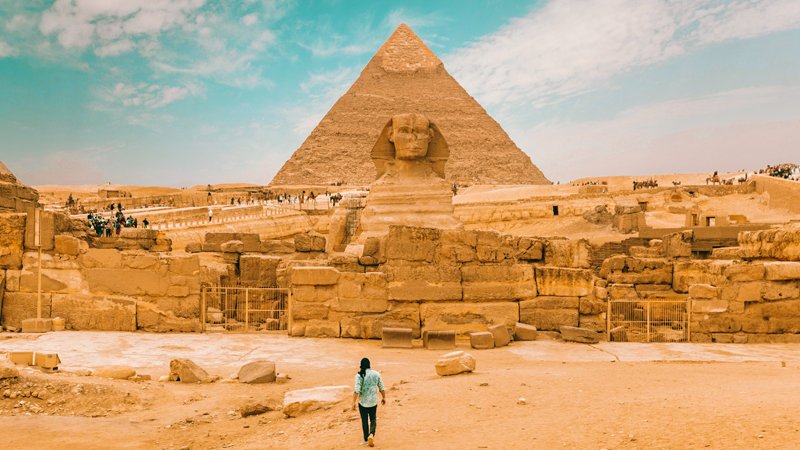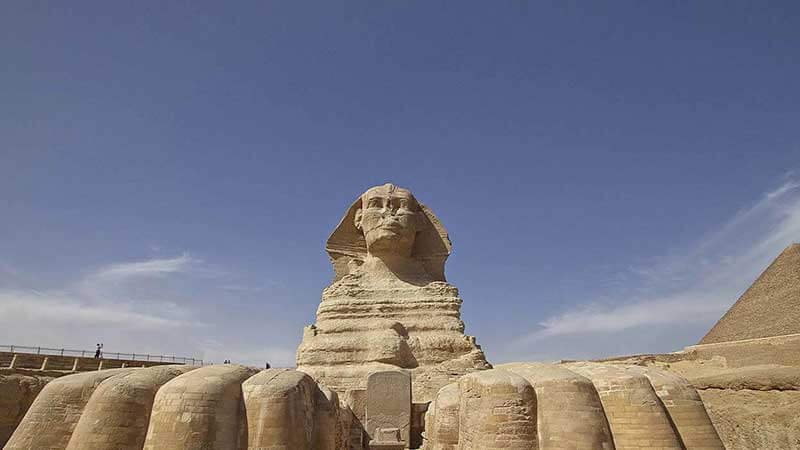Nestled on the illustrious Giza Plateau, alongside the iconic pyramids, stands an enigmatic testament to ancient Egyptian craftsmanship and ingenuity—the Great Sphinx of Giza. This captivating monument has enthralled the imaginations of people from around the world. This article will delve into its rich history, explore intriguing theories, and unveil remarkable facts that solidify the Great Sphinx’s enduring status as a symbol of Egypt‘s majestic past.
Don’t forget to read our related blogs:
The Great Sphinx of Giza: A Marvel of Epic Proportions

The Great Sphinx of Giza is an awe-inspiring limestone statue, an amalgamation of a lion’s body and a human head, believed to represent Pharaoh Khafre, who reigned during Egypt’s Old Kingdom in the 26th century BCE. Standing at an astonishing height of 66 feet and spanning a colossal length of 240 feet, it remains the most giant monolithic statue in the world.
Unveiling the Origins of the Sphinx
The origins of the Great Sphinx have long been a subject of vigorous debate among historians and archaeologists. Countless theories have emerged, some positing that it was crafted during Khafre’s reign, while others suggest a far older origin, potentially predating the pyramids themselves. Recent research introduces the intriguing possibility of a “re-carving” hypothesis, proposing that an earlier monument underwent modifications to give rise to the Great Sphinx of Giza we behold today.
Theories and Enigmatic Speculations
- The Solar Symbolism Theory
Some experts propose that the Sphinx was an astronomical marker aligned with the rising sun during the vernal equinox. This alignment could symbolize the sun god Ra, representing eternal life and divine power. - The Guardian of the Necropolis
Positioned facing the pyramids, the Sphinx’s role as a guardian is a topic of speculation. It is believed to have protected the tombs of pharaohs and the treasures concealed within these sacred resting places. - The Missing Nose Mystery
The Sphinx’s nose, or rather the lack thereof, has sparked curiosity and numerous theories. Erosion and intentional damage are among the proposed explanations, yet the truth remains mysterious. - The Secrets Concealed Within
Long associated with hidden chambers and passageways, the Great Sphinx may hold undiscovered cavities beneath its monumental form, potentially concealing ancient artifacts or the long-forgotten knowledge of a bygone civilization. Modern technologies like ground-penetrating radar have begun to unveil these hidden secrets.
Dedicated Restoration and Preservation

Throughout the centuries, the Great Sphinx has endured the effects of natural elements and human intervention, leading to erosion and damage. Tireless preservation efforts have been underway, with conservationists and archaeologists diligently working to safeguard both the structural integrity and historical significance of this treasured cultural relic. Therapeutic measures and protective barriers have been implemented to preserve its preservation for future generations.
A Journey to the Great Sphinx of Giza
A visit to the Great Sphinx is a transformative experience that transports visitors to an era characterized by grandeur and mystique. Tourists worldwide marvel at the intricate details of this remarkable statue, its compelling expression, and the historical landscape that envelops it.
FAQs: Unraveling the Sphinx’s Secrets
What is the significance of the Great Sphinx of Giza?
The Sphinx holds immense cultural and historical significance, representing the grandeur of ancient Egyptian civilization and symbolizing protection and power.
Can you enter the Sphinx?
No, the interior of the Sphinx is not accessible to the public, primarily due to preservation and safety concerns.
What happened to the Sphinx’s nose?
The exact cause of the missing nose remains uncertain, with theories ranging from erosion to deliberate destruction by vandals.
How old is the Great Sphinx?
The construction date of the Sphinx remains a topic of debate, but it is believed to date back over 4,500 years.
Are there any hidden chambers under the Sphinx?
Researchers remain intrigued by the possibility of undiscovered rooms or passageways beneath the Sphinx, but conclusive evidence has yet to be found.
Can you see the Sphinx without visiting the pyramids?
Yes, visitors can behold the Great Sphinx of Giza separately from the pyramids on the Giza Plateau.
In Conclusion
The Great Sphinx of Giza stands as an enduring enigma, encapsulating the mysteries of ancient Egypt and the boundless ingenuity of its people. As visitors and researchers continue their quest to unravel its secrets, the Sphinx remains a timeless symbol of human achievement and the relentless pursuit of knowledge. Its allure and intrigue will undoubtedly endure for generations to come, preserving the captivating history of Egypt’s fascinating past.


